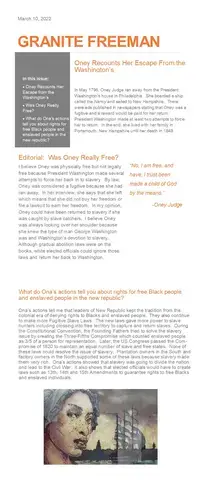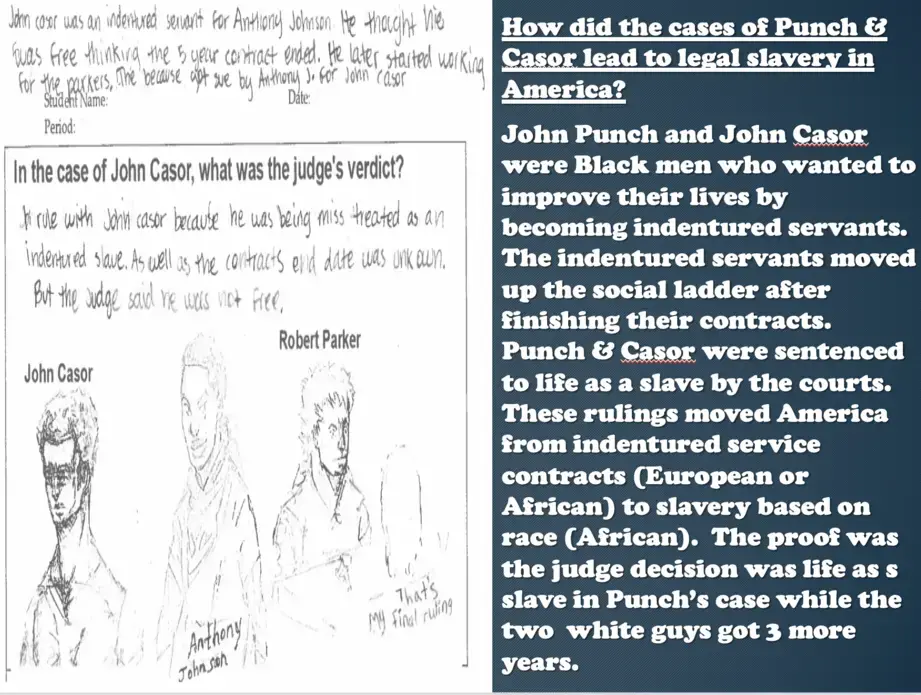This unit was created by social studies educators in Fort Worth, TX Schools, as part of the 2021 cohort of The 1619 Project Education Network. It is designed for facilitation across approximately 2-3 weeks, or 6-11 class periods.
Objectives and Outcomes
- Students will understand the difference between pre-colonial and colonial slavery by examining the social structure in West Africa and the Americas.
- Students will understand that colonial leaders codified slavery to assign a legal status to Africans in the colonies.
- Students will evaluate how leaders of the new republic created founding documents to perpetuate and protect the institution of slavery.
- Students will analyze how free blacks and fugitive slaves challenged the institution of slavery in the new republic.
Essential Questions
- How did slavery connect to, and/or impact, individuals in West Africa?
- Why did West African leaders participate in the transatlantic slave trade?
- How did the transatlantic slave trade impact the continent of Africa?
- What were similarities and differences between social statuses of indentured servants and enslaved people?
- How was slavery codified in the colonies?
- How did slave codes define an individual’s social status in colonial America?
- In the Declaration of Independence, did “life, liberty and pursuit of happiness” apply to all individuals living in the 13 colonies?
- Did President Washington have the authority to nullify federal laws addressing fugitive slaves?
- What actions did slaves and free blacks take to resist the institution of slavery?
Unit Overview
West African leaders supplied Portuguese slave traders with people who were enslaved as part of the transatlantic slave trade. Many of the people sold into slavery were captives of war. This practice decreased the population in West Africa and increased the spread of slavery in the Americas.
Although slavery was a part of West African societies, individuals who were enslaved in West Africa before colonization of the Americas were generally war captives, convicted of serious crimes, holding debt, or individuals who were enslaved by a group as part of a political military action against another group. Being enslaved did not prevent individuals from moving between social classes and acquiring wealth. Enslavement also didn’t prevent individuals from retaining civic rights and privileges in these societies.
Colonial slavery was an especially brutal and violent institution that deprived enslaved people of all rights and freedoms. Colonial leaders codified slavery to assign a legal status to Black people in the colonies. As a result, laws supporting slavery in the British colonies that would become the United States established a social structure that created a wealthy upper class, opportunities for poor whites to elevate their social status and acquire wealth, and access to a viable source of labor and political power resting in the hands of a small group of wealthy people with political power.
In this unit, students will investigate slavery and resistance to enslavement in West African societies, the characteristics of colonial slavery, and how slaves codes systematically deprived free and enslaved Black people of rights and freedoms.
Students will also analyze text from the Declaration of Independence, which was drafted by Thomas Jefferson in 1776. Students will explore how Thomas Jefferson addressed slavery in an initial draft of this document. They will also analyze whether the phrase “life, liberty, and the pursuit of happiness” applies to all individuals living in the colonies, and domestic and global reactions to this document.
Finally, students will investigate President George Washington’s role as the head of the first executive branch in the United States. They will evaluate how Washington and the executive branch enforced the laws outlined in the Constitution and investigate if Washington broke his oath of office by violating the Fugitive Slave Act of 1796 to pursue the capture of Ona Judge.
Performance Task
- Task for lessons related to pre-colonial slavery:
Students will design a poster or storyboard that illustrates the social status of enslaved people in pre-colonial Africa and the role of West African leaders in the transatlantic slave trade.
- Task for lessons related to indentured servitude:
Students will create a written or video response to the following questions:
- Why did Jamestown create dual legal systems for Africans and Europeans in the colonies?
- How did these systems support the establishment of codified slavery?
- Task for lessons related to Ona Judge:
Students will write an op-ed responding to one of the following prompts:
- In the New Republic, are the principles of “all men are created equal” and “freedom for all” a goal or reality? Why or why not?
- In the New Republic, should elected officials such as George Washington be able to use executive privilege to nullify or ignore federal and state laws that challenge the status quo? Why or why not?
Six-lesson unit plan for teachers, including pacing, texts and multimedia resources, guiding questions for group discussions, and three performance tasks for the unit. The unit also includes guidance for differentiation and scaffolding for students with diverse learning needs. Download below, or scroll down to browse the unit resources.
CCSS.ELA.LITERACY.RH.6-8.1
Cite specific textual evidence to support analysis of primary and secondary sources.
CCSS.ELA.LITERACY.RH.6-8.6
Identify aspects of a text that reveal an author's point of view or purpose (e.g., loaded language, inclusion or avoidance of particular facts).
CCSS.ELA.LITERACY.RH.6-8.7
Integrate visual information (e.g., in charts, graphs, photographs, videos, or maps) with other information in print and digital texts.
CCSS.ELA.LITERACY.RH.6-8.9
Analyze the relationship between a primary and secondary source on the same topic.
The following screenshots and quotes capture responses by students from Forth Worth, Texas in spring 2022 to the second performance task in this unit. Students are reflecting on the three court cases that reflect the how indentured servants and enslaved people were differentiated and treated differently under the laws of the colonies.
"John Casor wanted to be treated like the other indentured servants...The courts did not protect Casor and made him a slave for life."
Quote from a Forth Worth, Texas Student who participated in this unit in spring 2022
"The unfair treatment of Black people in America started in the colonies and continues today."
QUOTE FROM A FORTH WORTH, TEXAS STUDENT WHO PARTICIPATED IN THIS UNIT IN SPRING 2022
The following screenshot captures a response by a student from Forth Worth, Texas in spring 2022 to the third performance task in this unit. The student created an infographic capturing his reflections on the case of Ona Judge, who escaped a plantation where she was enslaved by the family of President George Washington.





